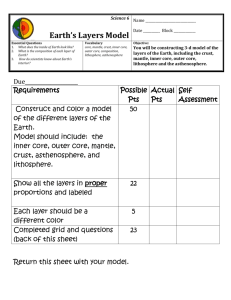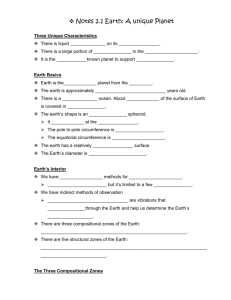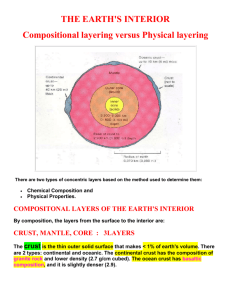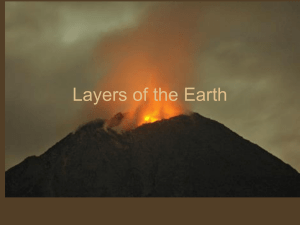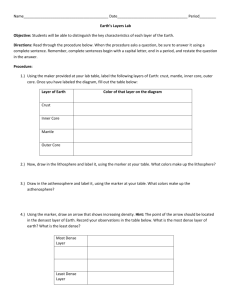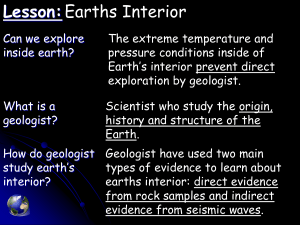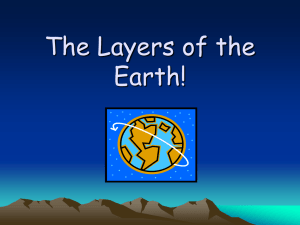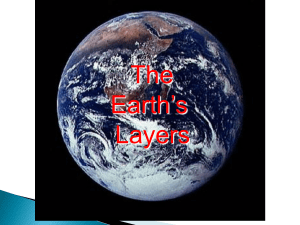Earth`s Internal Structure
advertisement
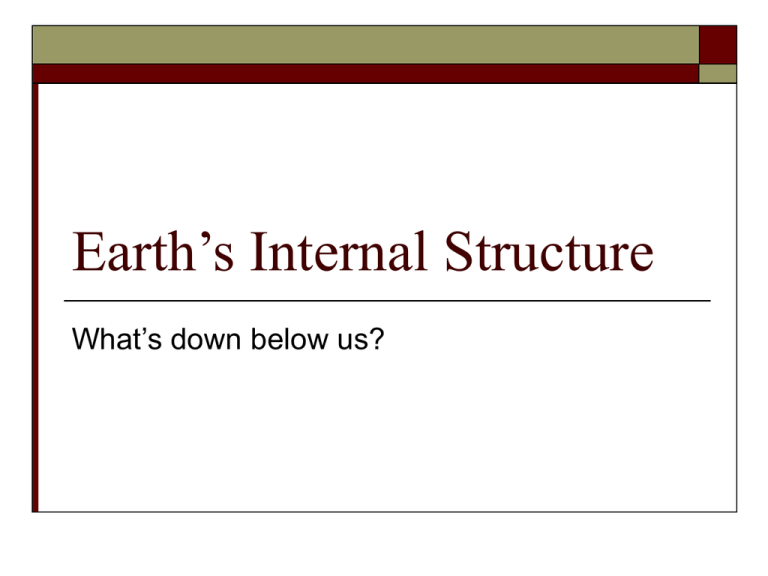
Earth’s Internal Structure What’s down below us? Earth’s Internal Structure The Earth is made up of a variety of materials. However, it is arranged into layers. The solid materials of the Earth are separated into layers according to composition and mechanical properties. Earth’s Internal Structure Earth can be divided into 3 main compositional layers: (made up of different materials) Crust (outside of Earth) Mantle Core (very inside) Earth’s Internal Structure Layers based on physical (mechanical) properties are: Lithosphere (most outer layer) Asthenosphere Mesosphere Outer Core Inner Core Earth’s Internal Structure The Earth’s interior consists of a series of shells of different compositions and mechanical properties. Earth is called a differentiated planet because of its separation into layers. The Earth consists of internal layers of increasing density toward the center of the Earth. Earth’s Internal Structure The internal layers were produced as different materials rose and sank so that the least dense materials were at the surface and the most dense materials were in the center of the planet. Therefore, gravity is the force behind Earth’s differentiated planet. Chemical Composition Crust is the outermost compositional layer of the Earth. Crust of the continents is distinctly different from the crust beneath the ocean floor. Continental crust is much thicker (up to 75km), is composed of less-dense grantic rock, is strongly deformed and includes the planet’s oldest rocks (billions of years in age). Oceanic crust is only about 8km thick, is composed of denser volcanic rock called basalt and is comparatively undeformed by folding and is geologically young (less than 200 million years in age). Chemical Composition The mantle is the next major compositional layer of the Earth. It surrounds or covers the core. The zone is about 2900km thick and constitutes the great bulk of Earth (82% of its volume and 68% of its mass). The mantle is composed of silicate rocks that also contain abundant iron and magnesium. Fragments of the mantle have been brought to the surface by volcanic eruptions. The mantle’s density increases with depth (being the densest where it is closest to the core). Physical Properties Physical properties of a material are also known as mechanical properties. They tell us how a certain material responds to force, how weak or strong it is and whether it is a liquid or solid. Physical Properties The lithosphere (rock sphere) is the solid, strong and rigid outer layer of the Earth. It includes the crust and upper most part of the mantle. It varies greatly in thickness, from as little as 10km in some oceanic areas to as much as 300km in some continental areas. Physical Properties The asthenosphere (weak sphere) is within the upper mantle. In the asthenosphere the temperature and pressure are just right so that part of the material melts or nearly melts. Under these conditions, rocks lose much of their strength and become soft and plastic and flow slowly. Convection currents exist here as the rock heats, becomes less dense, rises, then cools near the lithosphere and drops back into the depths of the mantle. Physical Properties The mesosphere (middle sphere) is the region between the asthenosphere and the core. The rock here is stronger and more rigid than in the Asthenosphere. This is because the high pressure at this depth offsets the effect of high temperature. Physical Properties The Earth’s core has 2 distict parts: The Inner Core: Is solid Radius of about 1200 km Chiefly made of iron The Outer Core Is liquid Thickness of about 2270km (about twice of that of inner core) Physical Properties Earth’s core is extremely hot. Heat loss from the core and the rotation of Earth cause the liquid outer core to flow and rotate faster than the inner core. This circulation generates Earth’s magnetic flow. Earth’s Outermost Layers The outermost layers of the Earth are the atmosphere, hydrosphere and biosphere. The atmosphere is composed of 78% nitrogen, 21% oxygen and minor amounts of other gases such as carbon dioxide and water vapour. The earliest atmosphere was much different; it was essentially oxygen free and consisted largely of carbon dioxide and water vapour. The present carbon dioxide “poor” atmosphere developed as soon as limestone began to form in the oceans, tying up the carbon. Oxygen was added to the atmosphere when plants evolved. Earth’s Outermost Layers The hydrosphere is the total mass of water on the surface of our planet. Water covers about 71% of the surface. About 98% of this water is in oceans, while only 2% is in streams, lakes, groundwater and glaciers. It has been estimated that if the Earth’s surface was smoothed out, a global ocean would cover Earth to a depth of 2.25km. The biosphere is the part of Earth where life exists.
